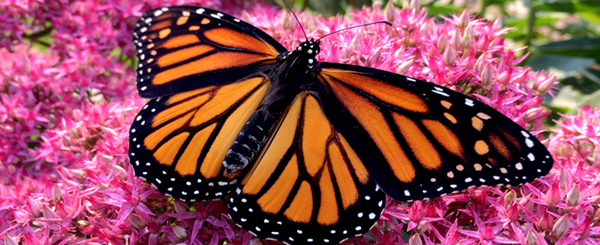A monarch butterfly named Monet, reared by Melinda Lowe of ITD’s Environmental Section, recently made history by completing a flight from Lowe’s Treasure Valley home to a swimming pool in California.
The monarch (Danaus plexippus) set out from Boise on Sept. 4, 2017, and was rescued from the pool March 2, 2018.
Biologists studying the movements of the declining species tracked the monarch by the research tag placed on her wing (see photo below). It is the first documented case of a monarch, tagged as part of Washington State University’s program, to make the journey from Idaho to California.
The monarch was reared in Idaho by Lowe, who brought her home in early August 2017. Lowe had a butterfly cage specially built for her, where Monet grew fat and happy. eating freshly picked showy milkweed leaves (see photo at right).
After a month, Monet emerged from her chrysalis and became a California-bound butterfly that Lowe released that evening, just four hours later.
“She immediately flew up and out of the yard and toward the west. “I flapped my hand waving goodbye. Such a bittersweet moment,” Lowe said.
The butterfly, officially named B1861, flew approximately 662 miles southwest and into southern California before settling in the greater Santa Barbara area.
“This is big news. Monet is the first Idaho monarch in my study to be recovered in California, and at six months of age, she is the longest-lived monarch documented in this Washington State University tagging effort,” said Dr. David James, an associate professor at WSU specializing in invertebrate conservation. “Monet will go down in Idaho monarch history, that’s for sure.”
The California homeowner found the butterfly a few hundred yards from a known overwintering site where the female butterfly likely spent the winter. After fishing her from the pool, the homeowner released the butterfly, which apparently was fine after the near-death experience. The homeowner then contacted Dr. James, who in turn contacted Lowe.
“Hopefully, she is now heading inland from Goleta, California, with dry wings seeking milkweed to lay her eggs,” said Dr. James.
The monarch butterfly is a national priority species for the U.S. Fish & Wildlife Service. Community-based projects in Idaho’s Treasure Valley and throughout the country are helping to enhance and restore habitat to benefit the monarch. This beautiful orange and black species is known for migration between its over-wintering grounds in central Mexico and California, to its spring and summer breeding grounds in the northern and interior portions of the United States and Canada. This butterfly requires milkweed plants to reproduce, and female monarchs will only lay eggs on milkweeds. Native milkweeds are the primary food sources for monarch caterpillars.
Monarch butterflies and other pollinators are in trouble. The decline of these species may be attributed to habitat fragmentation, urban and agricultural development, pesticide use and lack of nectar plants for food. In the case of the migratory monarch, the lack of native milkweed is believed to be a critical limiting factor.
Learn more about our efforts to save the monarch at https://www.fws.gov/savethemonarch/

